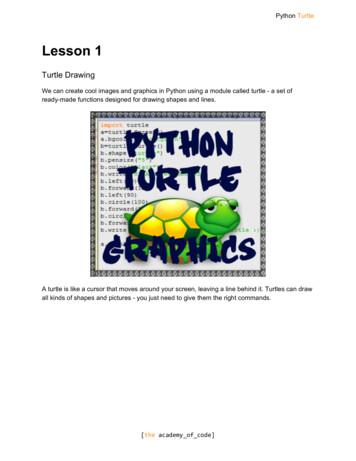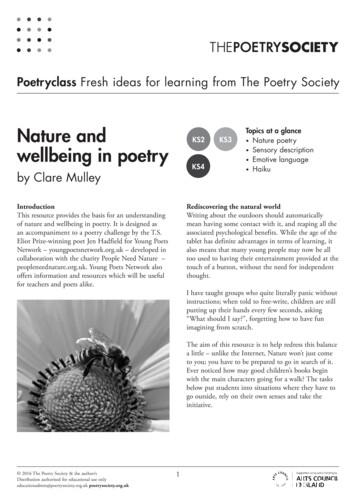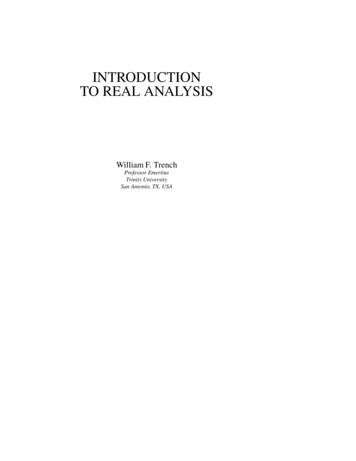POETRY UNIT - Home: Tina Spurlock
Common Core Lesson GuidePOETRY UNITPRE-AP ENGLISH 1
Common CorePOETRY UNIT
SECTION 1Focus StandardsEssential Question:How does poetry reveal what we might not otherwiserecognize?R.L. 9-10.4: Determine the meaning of words and phrases asthey are used in the text, including figurative and connotativemeanings; analyze the cumulative impact of several wordchoices on meaning and tone; how it sets a formal or informaltone.OVERVIEWStudents have already studied the short story and thenovel, students should now start to consider why poetryis different than prose. Students will examine the power and expressivepotential of imagery and figurative language. They will encounter multi-cultural and diverse poeticforms. Students will examine form that is found inmasterpieces in art and architecture. This will be away for students to correlate the significance of poeticform. R.I. 9-10.2: Determine the central ideas of a text and analyzeits development over the course of the text, including how itemerges and is shaped and refined by specific details; provide anobjective summary of the text.W. 9-10.8: Gather relevant information from multiple authoritative print and digital sources, using advanced searches effectively; assess the usefulness of each source in answering theresearch question; integrate information into the text selectvely to maintain the flow of ideas, avoiding plagiarism andfollowing a standard format for citation.2
S.L.9-10.5: Make strategic use of digital media ( e.g. textual,graphical, audio, visual, and interactive elements) inpresentations to enhance understanding of findings,reasoning, and evidence. Complete a literary research paper, citing at least threesources.LITERARY TEXTSL. 9-10.1: Determine command of the conventions ofStandard English grammar and usage when writing orspeaking.“ Ozymandias” Percy Bysshe .9-10.3: Apply knowledge of language to understand howlanguage functions in different contexts, to make effectivechoices for meaning or style, and to comprehend more fullywhen reading or listening.“The Raven” Edgar Allan eRaven.htmlSonnet 73 William ts/73.htmlOBJECTIVES:“Ode on a Grecian Urn” John Keatshttp://www.bartleby.com/101/625.html Define and offer examples or various forms of poetry. Identify the form, rhyme scheme, and meter of poemsstudied. Define and explain poetic devices, such as alliteration,assonance, consonance, and enjambment, and describe theways in which they help reveal the theme(s) of the poem. Recognize and explain the distinguishing characteristics ofvarious kinds of poetry, such as ballads, odes, lyric poetry,blank verse, haiku, and sonnets. Describe how poetry differs from prose and explain whyauthors would choose one form over another for a particularpurpose.“We Grow Accustomed to the Dark” Emily customed-to-thedark/“Mending Wall” Robert Frosthttp://allpoetry.com/poem/8469231-Mending Wall-byRobert Frost“ A Lemon” Pablo Nerudahttp://hellopoetry.com/poem/ode-to-a-lemon/3
“Saturday’s Child” Countee ��The Darkling Thrush” Thomas �Dream Variations” and “ In Time of Silver Rain”Langston 610“Poetry” Marianne allpoetry.com/poem/8495509In Time Of Silver Rain-by-Langston Hughes“Elegy Written in A Country Churchyard”Thomas text elcc“ I Ask My Mother to Sing” and “The Gift” by Li -Young Leehttp://www.poetrysociety.org/psa/poetry/poetry in motion/atlas/chicago/i ask my mot to sin/“The Sound of the Sea”Henry Wadsworth Longfellowhttp://www.hwlongfellow.org/poems poem.php?pid 163http://www.poetryfoundation.org/poem/171752“I Wonder Lonely as a Cloud” William 790Psalms 96 King James Biblehttp://www.bartleby.com/108/19/96.html“The Lady of 626“Lord Randall” /16141“Digging” and “The Underground”Seamus Heany“Campo di Fiori” Czeslaw inglePoem.do?poemId 13944
“The Reader” Richard MID/22140ART, MUSIC, AND g/toah/works-of-art/06.1021.77“In Trackless Woods” Richard featuresreviews.guardianreview36 ondoINFORMATIONAL TEXTS Faulkner in the University: Class Conferences at theUniversity of Virginia 1957-1958http://faulkner.lib.virginia.edu/page?id essays§ion intro “Crediting Poetry” Nobel Prize Acceptance Speech(1995) Seamus Heaneyhttp://www.nobelprize.org/nobel mlChartres Cathedral ( Chartres Cathedral.html Greek, Terracotta Hydria (circa 510 B.C.) Leonardo Di Vinci, Mona Lisa (1503-1506) Sandro Botticelli, The Birth of Venus ( 1486) nus.html Vincent Van Gogh, The Starry Night ( ght-Visions.html Michaelangelo, David ( ngelo david.htm The Partheon ( 473-432 BCE)http://www.timetrips.co.uk/parthenon.htm Frank Lloyd Wright, Fredrick C. Robie Househttp://www.galinsky.com/buildings/robie/5
MUSICGiacomo Puccini “Un bel Vedremo” ( Madame Butterfly 1904)when appropriate. Cite at least three pieces of evidence foreach LASS DISCUSSIONS.L. 9-10.1 and S.L. 9-10.2Most great poems explore one ideas or concept, oftendistilling it to its essence. Look carefully at threemasterpieces of art ( e.g. the Mona Lisa, The David, theParthenon). After looking at these works of art, do youbelieve that the artist who made them did similar things?Giacomo Piccini “ O mio babbino caro ( Gianni Schicchi ANATORY WRITINGR.L 9-10.4Write an informative/explanatory essay that compares andcontrasts the use of literary devices in two different poems.Discuss at least three aspects. Your teacher may give you theopportunity to write your first draft on a google doc and receivefeedback from classmates before publication.ART/INFORMATIVE/EXPLANATORY WRITINGR.L. 9-10.7 and W. 9-10.2View the image of the terra-cotta urn from the Archaicage of Greece. Write an essay in which you discuss theways in which reading Keats’s description of the urn is adifferent experience from viewing it.ART/INFORMATIVE/EXPLANATORY WRITINGR.L. 9-10-7RESEARCHR.L. 9-10.5, R.I. 9-10.6, W. 9-10.7, W.9-10.8, S.L. 9-10.2Select a poet and write a research paper which you analyzethe development of the writer’ss poetry in his/her lifetime,using at least three poems and citing at least threesecondary sources. Begin by defining a research questionand refine it as necessary as you conduct your research.Cite sources carefully and distinguish clearly betweenparaphrasing and quoting. You might include links toonline images that illustrate the information that you wantWhat similarities can we find between great poems andmasterpieces of visual art? Choose one of the formal elementsof poetry: rhythm, tone, structure, or imagery. How mightthese poetic elements to art such as line, space, color, ortexture? Choose a painting such as “Starry Night” or “TheBirth of Venus” and examine its formal elements. How doesthe artist utilize each element in each artwork? Now think ofone of the poems that you have read. Select a formal elementin each work and write and essay discussing how the authorand the painter develop those elements, comparing the two6
This socratic question may also be used as an essay topic. Besure to include at least three reasons or examples form texts tosupport your argument. Your teacher may give you theopportunity to share your initial thoughts on a classroom blogin order to get feedback from your classmates.the information that you want to share.Your teacher may giveyou the option of adding a multimedia component to yourpaper, such as a digital slideshow, to highlight your key points.SPEECHS.L. 9-10.6Select a poem and recite it from memory. Include anintroduction that states: Title, author, and type of poem How the poem exemplifies the stated type of poetry.ORAL PRESENTATIONS.L. 9-10.4, S.L. 9-10.2, S.L. 9-10.6Discuss whether you agree with Seamus Heany when hecredits poetry “ because credit is due to it, in our time and inall time, for its truth to life, in every sense of that phrase.” Saywhy or why not, and give examples from poems studied orother poems to illustrate your position. State your thesisclearly and include at least three pieces of evidence to supportit. Your teacher may ask your to record your presentation as apodcast for publication on the class web page.Record your recitation using a video camera so you canevaluate your performance for accuracy.WRITING ( ARGUMENT) AND SOCRATIC CIRCLESR.L. 9-10.6, S.L. 9-10.1, S.L. 9-10.3RESEARCH AND INFORMATIVE/EXPLANATORYWRITINGAre poems better when they follow a strict rhyme or meter?Why or why not? This socratic circle question may also be usedas an essay topic. Be sure to include at least three reasons orexamples form the texts to support your argument. Yourteacher may give you the opportunity to share your initialthoughts on the classroom blog in order to get feedback fromyour classmates.R.L. 9-10.4, R.L. 9-10.9, W. 9-10.2, W. 9-10.7, S.L. 9-10.5Read and listen to or watch Seamus Heaney read “ TheUnderground”. Identify and read more about the literary andother allusions in the poem and explain why they mightenhance appreciation of the poem. (Extension: Discuss howthe use of enjambment adds layers of meaning to the poem.Try writing a poem usisng enjambment to achieve the effect.WRITING (ARGUMENT) AND SOCRATIC CIRCLESR.L. 9-10.4, R.L. 9-10.1, S.L. 9-10.3Which is a more effective form of communication-literal orfigurative language?7
NOTETAKING AND NARRATIVE WRITINGR.L. 9-10.4, W. 9-10.2Select a poem ( from the list of poems and links) and performthese tasks: Annotate the poem for the poet’s use of poetic devices Using your annotations. explicate the poemGRAMMAR AND USAGEL. 9-10. 1, L.9-10.3Parts of Speech ReviewPrepositions: position, direction, time, purpose, and means,possession, accompaniment, comparison, support or opposition,exception, concession; combining prepositions ( e.g., in front of)In a single paragraph ( at least 100 words), discuss the poem’stheme and the way in which the poet’s use of these devicesilluminates the theme.Prepositions Versus Adverbs: Look at a photograph takenduring a basketball game of other sporting evnet ( e.g., in theschool newspaper or other newspaper). Then, using adverbs andprepositions listed by your teacher, write two sentences for eachevent that describe what is happening in the picture (e.g., use thewords, up, through, or behind).NARRATIVE WRITINGR.L. 9-10.4, W. 9-10.3(The creative writing assignment below follows the reading andclose study of “Mending Wall” by Robert Frost).In “Mending Wall”, Frost uses an extended metaphor ( the wall)to convey an idea. Consider an idea that you want to express andthen think of a metaphor that will enable you to convey yourideas in a poem.MECHANICSL.9-10.2Colons:Select a newspaper or magazine that uses solons.Highlight where they are used and explain why. Once you select the metaphor, create a web that depicts themetaphor ( e.g, a volcano could likely generate words like: noisy,ash, burn, majestic) Begin to string words ( e.g., “the burning ash of morning/creeps into my aching heart.” Using the generated phrases, compose a poem.8
Type to enter text9
close study of “Mending Wall” by Robert Frost). In “Mending Wall”, Frost uses an extended metaphor ( the wall) to convey an idea. Consider an idea that you want to express and then think of a metaphor that will enable you to convey your ideas in a
Laila Ragab Marlena Rasmussen Prathamesh Sabarinath Lia Schwalje Molly Van Wyk POETRY 3 STORIES 27 BURSTS 31 OF CREATIVITY Inside this issue: GRANT SCHOOL LITERARY MAGAZINE . POETRY Page 3 By: Laila Ragab. POETRY Page 4 . POETRY Page 5 . POETRY Page 6 . POETRY Page 7 . Page 8 . POETRY Page 9 . POETRY Page 10 . POETRY Page 11 . POETRY Page 12 .
Poetry Texts Structure and features of poetry texts PURPOSE Poetry captures the essence of an object, feeling or thought. Poetry for children should reflect the emotions of childhood, making students feel sensory experiences to an intensified degree and satisfying their natural response to rhythm. FORMS OF POETRY Lyric poetry
Make a turtle and load it into a variable. tina turtle.Turtle() We have named the turtle Tina, however, you can give the turtle any name you want. Set the colour that the turtle will use to draw the shape. tina.color( ' blue' ) Set the style of the turtle with a function called shape. tina.shape( ' turtle' )
affirmed that poetry should be shared every day—meshing with every area of the curriculum. To spark a love of poetry, to bring poetry into children’s lives in a meaningful, unforced way is one of the best gifts we can give. Reading, writing, collecting, and sharing poetry is my passion. The power of poetry forever mystifies me, for so much .
2.6.1 The Characteristics of English Poetry 19 2.6.2 The Importance of Poetry in the Classroom 21 2.6.3 Considerations and Principles of choosing an Educational Poetry 26 2.6.4 Strategies for Teaching Poetry in the Classroom 27 2.7 The Impact of Using Poetry on Devel
Poetryclass Fresh ideas for learning from The Poetry Society 1 Nature and wellbeing in poetry by Clare Mulley Introduction This resource provides the basis for an understanding of nature and wellbeing in poetry. It is designed as an accompaniment to a poetry challenge by the T
ESSENTIALS IN LITERATURE LEVEL 9: SAMPLE POETRY POETRY: LECTURE Day 1 - Elements of Poetry, Poetry Structure Day 2 - Sound Devices, Other Elements of Poetry Day 3 - Figurative Language DREAMS Day 1 - Meet the Author, Making Life's Connections Day 2 - Access the Backdrop, Analyzing Figurative Language: Metaphor, Elements of Poetry: Mood and Tone, Analyzing Figurative Language:
algebra, and differential equations to a rigorous real analysis course is a bigger step to-day than it was just a few years ago. To make this step today’s students need more help than their predecessors did, and must be coached and encouraged more. Therefore, while strivingthroughoutto maintain a high level of rigor, I have tried to writeas clearly and in- formallyas possible. In this .























